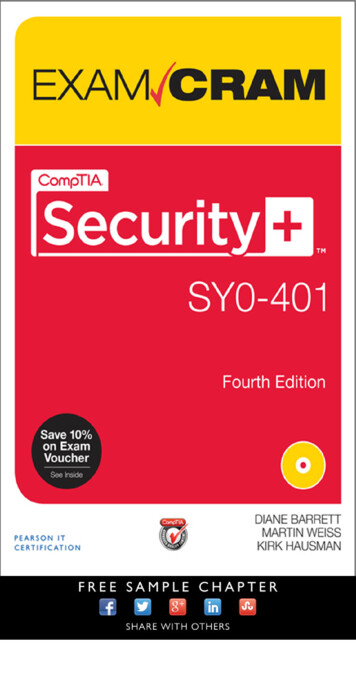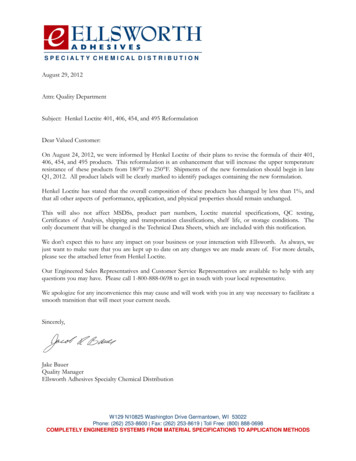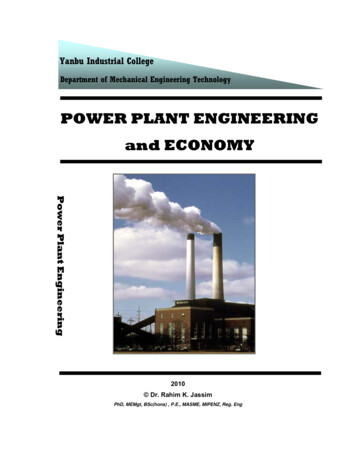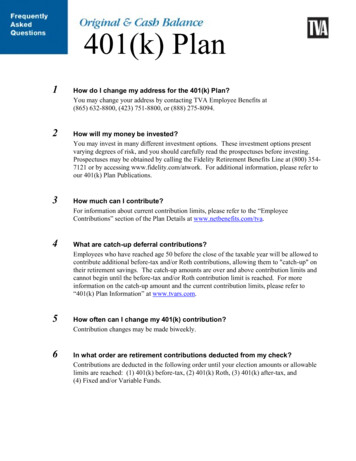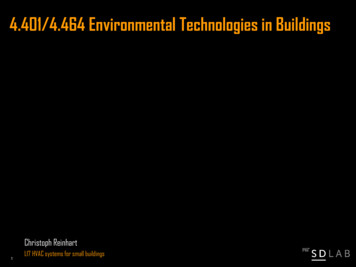
Transcription
4.401/4.464 Environmental Technologies in BuildingsChristoph Reinhart1L17 HVAC systems for small buildings
Thermal Module Thermal Mass & Heat Flow Insulating Materials Window Technologies Shading Integrated Façade Design Ventilation Internal Gains & Load Calculations HVAC for Small Buildings HVAC for Large Buildings2
Course Project Workflow Provide a project narrative; analyze the climate; set your project targets General: Generate a Rhino model that uses the daylighting layers for representation and daylighting analysis aswell as a set of separate zone layers for energy. For energy set up a simple simulation model in DIVA4 (with surrounding context) and determine orientation,WWRs and suitable upgrades levels (lighting, insulation and shading) To add PV using the DIVA/ArchSim PV module. Show space layouts in plan on a separate layer.3
HVAC Systems4
General Considerations So far we have concentrated on quantifying and optimizing energy loads in buildings for heating,lighting, cooling, and internal gains using basic building design and passive systems concepts. Now we are looking at the mechanical heating & cooling systems that are required to meet theseloads.5
General Considerations Internal gains and lighting loads are nearly always met with electricity in which case thermal loads andenergy use are identical. Mechanical heating and cooling systems have a maximum capacity, i.e. a maximum output at anyparticular point in time. If heating or cooling loads are temporarily higher than the system capacity the building ‘under-heats’(should not happen) or overheats (may happen once in a while). If a system is always running significantly under its maximum capacity it always runs at part load andaccordingly has been oversized which might result in unnecessarily high initial investment costs andnon-optimized system part loads.6
General Considerations Is your building envelope or internal load dominated? You need cooling in the latter case. The closer you work with your HVAC engineer and the better you are able to predict the temporal load curve ofyour building, the more informed will be your choice when designing your HVAC system. Variables to consider include:o thermal behavior of your building (thermal mass, solar gains, occupancy patterns)o peak loadso part load curves for your equipmento size of system unitso return air/water temperature7
Potential ConflictThis image is from Anca D. Galasiu & Christoph F. Reinhart, "Current daylighting design practice: a survey," Building Research &Information, 36:2, 159-174. This journal is available online at 10701549748.8 The compensation of the HVAC engineer is usually linked to the cost of the purchased equipment. ASHRAE sizing methods do not consider solar gains for heating capacity.
Integrated Project Delivery“Integrated Project Delivery (IPD) is a project delivery approach that integrates people, systems, businessstructures and practices into a process that collaboratively harnesses the talents and insights of allparticipants to optimize project results, increase value to the owner, reduce waste, and maximize efficiencythrough all phases of design, fabrication, and construction. IPD principles can be applied to a variety ofcontractual arrangements and IPD teams can include members well beyond the basic triad of owner,architect, and contractor. In all cases, integrated projects are uniquely distinguished by highly effectivecollaboration among the owner, the prime designer, and the prime constructor, commencing at early designand continuing through to project handover.”--American Institute of Architects, 2007Note: IPD in building design is linked to the concept of a Building Information Model (BIM).9
MacLeamy Curve10 AIA. All rights reserved. This content is excluded from our Creative Commons license. For more information, see https://ocw.mit.edu/help/faq-fair-use/.
Heating11
What was the first heatingsystem?12Photo courtesy of Rebecca Dominguez on Flickr. License: CC BY-NC-SA.
Heating with WoodImproved Indoor Air QualityUses heated room airfor combustionUses heated room airfor combustionOpen FireChimney (efficiency 10%) Basic Physics: Controlled combustion of a medium and delivery of heat to a space through a combination of heattransfer mechanisms13Photo courtesy of Rebecca Dominguez on Flickr. License: CC BY-NC-SA.
Heating with WoodAir ExhaustClosed Combustion ChamberDedicated AirIntakeRetrofitted Fireplace14Left: photo courtesy of Rebecca Dominguez on Flickr. License: CC BY-NC-SA.Right: photo courtesy of Earthworm on Flickr. License: CC BY-NC-SA.
Heating with WoodLeft: photo courtesy of I G on Flickr. License: CC BY.151515151515Right: image Ceramics Today. All rights reserved. This content is excluded from our Creative Commons license. For moreinformation, see https://ocw.mit.edu/help/faq-fair-use/.
Central Heating Separating the combustion process from the space. Requires a distribution system.Hydronic Radiators: Radiation & ConvectionConvection: Movement of Airor WaterForced Air: ConvectionCentral Heating System16Photo courtesy of Rebecca Dominguez on Flickr. License: CC BY-NC-SA.
Heating Systems A heating system consists of three components.Source EnergySolarWoodOilGasBiomassElectricity17Heating SystemFurnaceSolar collectorBaseboard heaterHeat pumpDistribution SystemAirWaterElectricity
Pros and Cons of Various Heating r Ventilation, cooling and humidity control Space requirementsWater Limited space requirementsRadiant heating and cooling No ventilationNo humidity controlElectricity Space requirementsFlexibility; easy to control, cheap to install No ventilationNo humidity controlHigh operation costs
Examples of hydronic heating distribution systemsPerimeter loopOne pipeTwo pipe reverse returnImage from Stein, Reynolds, Grondzik and Kwok (2006) John Wiley & Sons. All rights reserved. This content is excluded from our Creative Commons license. For more information, seehttps://ocw.mit.edu/help/faq-fair-use/.19 To consider: pipe expansion, air vents and water drains, pipe insulation
Radiant PanelsRadiant floor A radiant floor has a larger heat exchange surface than a conventional radiator and may hence operate at a lowertemperature.20Left: public domain photo courtesy of Rpvdk on Wikipedia.Right: photo courtesy of Oregon Department of Transportation on Flickr. License: CC BY.Radiant ceiling
Condensing source unknown. All rights reserved. This content is excluded from our Creative Commonslicense. For more information, see https://ocw.mit.edu/help/faq-fair-use/. As opposed to a regular furnace, a high-efficiency or condensing furnace extracts so much heat from the exhaust gases thatwater vapor in the exhaust condenses. Such furnaces must be designed to avoid the corrosion that this highly acidic condensate mightcause. No chimney is required. Typical price premium for a high-efficiency furnace is 1000. Assuming a 200 utility rebate, 100 federal incentives, 15%efficiency gain, the payback time lies around 3.5 years or less. Variable-speed DC motor fans reduce noise and save electricity.21
Condensing FurnaceImages: source unknown. All rights reserved. This content is excluded from our Creative Commons license. For more information, see https://ocw.mit.edu/help/faq-fair-use/.22
Heating with PelletsWood pelletsPellet stove Ideally a byproduct of sawmilling, very dense, low humidity content ( 10%) Due to regular shape and consistent burning efficiency suitable for automatic feeding. Both room furnaces and central heating. Requires local provider and distribution system. C02 content depends on the harvesting process of the underlying biomass.Left: public domain photo courtesy of Tom Bruton on Wikipedia.Center: public domain photo courtesy of USDA.23Right: Pellergy. All rights reserved. This content is excluded from our Creative Commons license. For moreinformation, see https://ocw.mit.edu/help/faq-fair-use/.Tanker delivering pellets
Pellet Stove Diagram24 Alliance for Green Heat. All rights reserved. This content is excluded from our Creative Commons license. For more information,see https://ocw.mit.edu/help/faq-fair-use/.
US Market Penetration (2014)Image courtesy of FutureMetrics. Used with permission. States with the highest penetration of wood pellets lack a natural gas infrastructure.25
Economics (ballpark)26Image courtesy of FutureMetrics. Used with permission.
International Pellet MarketsImage courtesy of FutureMetrics. Used with permission.27
Heating with ElectricityElectric baseboard heater Resistance heater: 1 kWh electric equals 1 kWh thermal Heat pump: 1 kWh electric yields 1 kWh thermal28Left: photo courtesy of Home Spot HQ on Flickr. License: CC BY.Right: photo courtesy of Green Energy Futures on Flickr. License: CC BY-NC-SA.Air Source Heat Pump
Heat PumpsA heat pump is a mechanical heating and cooling system driven by electricity. It is based on a compressiverefrigeration system that can run ‘both ways’. Compressive refrigeration relies on liquefaction and evaporationof a refrigerant.Heat SourceHeat SinkTsource T Sink29
Heat PumpsA heat pump is a mechanical heating and cooling system driven by electricity. It is based on a compressiverefrigeration system that can run ‘both ways’. Compressive refrigeration relies on liquefaction and evaporationof a refrigerant.Heat SinkHeat SourceEvaporator30Condenser
Heat PumpsHeat OutHeat InPublic domain image courtesy of Internet Archive.31
Refrigerator32 source unknown. All rights reserved. This content is excluded from our Creative Commons license. For moreinformation, see https://ocw.mit.edu/help/faq-fair-use/.
Can you cool a room with an open fridge?Image courtesy of Ross Berteig on Flickr. License: CC BY.33
Typical Through-The-Wall AC UnitImage courtesy of Pbroks13 on Wikipedia. License: CC BY.34
Refrigerants Up until the mid-1990s chlorofluorocarbon (CFC) gases were usedwhich are strong greenhouse gases. In the mid-1990s CFCs were banned and replaced withhydrochlorofluorocarbons (HCFCs). In 2010s HCFCs are being replaced with hydrofluorocarbons (HFC)35
Heat Pumps Heat pumps typically draw heat from the ambient air or the ground making them either air source or ground source heat pumps. Heat pumps can be reversed into a cooling device. In fact, ground source heat pumps should be used for both heating and cooling as theground temperature otherwise keeps on rising or falling with time. Mini split (air to air heat pump) systems are becoming increasingly popular in the US and abroad.36
Ground TemperaturesImage courtesy of Natural Resources Canada. Used with permission. The temperature of undisturbed ground oscillates around the annual mean air temperature.37
Types of Earth ConnectionImage courtesy of Natural Resources Canada. Used with permission. Plastic tubing usually used for outside heat exchanger.38Image courtesy of NaturalResources Canada. Usedwith permission.
Horizontal Ground Source Heat Pump Installation depth about 1.5 m.39Public domain image courtesy of Marktj at Wikipedia.
Heat Pump ExampleBlackstone Building (architecture: Bruner Cott) Ground source heat pumps should be used for both heating and cooling as the ground temperature otherwise keeps on rising orfalling with time.40
Ground Source Heat ExchangerLamparter BuildingWeilheim, Germany41
Ground Source Heat Exchanger Preconditions incoming air in summer and winter. Moisture control can be an issue. Underground air ducts shouldtherefore be accessible for cleaning.42Photo courtesy of Fraunhofer ISE. Used with permission.
Environmental Concept43
Heat Pump – General Considerations Historically, utilities tend to promote heat pumps since they tend to run under capacity in the winter. Nowadays heat pumps are promoted as the goal is to reach an all electric energy supply system. As the electricgrid is getting decarbonized, heat pumps are again considered to be a viable, energy-saving technology. Heat pumps work well with radiant heating systems as they provide low temperature energy.44
GeothermalContractors and developers frequently refer to ground source heat pumps as “geothermal.”Geothermal is the direct use of a high temperature heat stored in the earth. One has to go deep. The geothermalgradient of temperatures through the crust is 25–30 C per kilometer.Sonoma Power Plant45Left: public domain image courtesy of US Department of Energy.Right: public domain image courtesy of Stepheng3 at Wikipedia.
Simulation Game ChoicesBoiler Heating DX/ACBaseboard Heating,DX/AC46GSPH for Heating and Cooling
Cooling47
Who grew up in a house withoutair–conditioning?48
Willis Carrier (1876-1950) 1902 in Buffalo, NY, inventor of air conditioning Air conditioning performs four functions:1.) control temperature2.) control humidity3.) control air circulation and ventilation4.) cleanse the air.Public domain image courtesy ofCarrier Corporation on Wikipedia.49
According to Carrier Corp., “The world started to become aware of air conditioned theaters when Carrier brought acentrifugal chiller to the Rivoli Theater in New York’s Times Square in 1925.”50Photo courtesy of Joseph at Cinema Treasures. License: CC BY.
Cooling – General Considerations In 1950 air conditioning was still considered a luxury. Now it is being viewed as a necessity and even a safetyissue (e.g. in cars). Type A office space is air conditioned by definition. Load considerations and the afternoon peak. Highest demand in the summer (even in the Northeast).51
Cooling SystemsThere are two main types of mechanical cooling systems: Compressive Refrigeration relies on liquefaction and evaporation of a refrigeran
Heat Pumps. nbyelectricity.Itisbasedonacompressive ssiverefrigerationreliesonliquefaction andevaporation ofarefrigerant. Heat Source. Heat Sink. Evaporator. Condenser. 30



